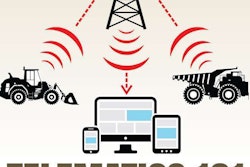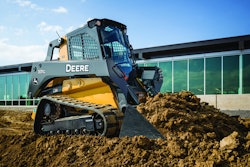
Telematics already play a major role in the heavy truck and equipment industries and will likely become a dominant technology in the years to come.
That’s the conclusion of a global survey published today (Tuesday, August 22) of more than 260 companies primarily in construction but also the oil and gas, and mining and aggregates industries. The 2017 Telematics Benchmark Report from Teletrac Navman noted that 81 of the respondents are using telematics in their companies or plan to do so next year and 62 percent are looking a variety of emerging technologies.
Worker shortage and mobile devices
One of the top challenges facing these contractors is the worker shortage. The survey said that technology could help attract a younger workforce and noted that all but 36 percent of the companies use mobile devices to connect with workers for fleet management purposes.
Some 57 percent of the companies give mobile devices to their workers and the other 7 percent have employees linking their personal devices to company systems. Nine percent of the respondents said they would incorporate mobile technology into their fleet management next year.
Most popular technologies
Safety and productivity are the big drivers for the 62 percent who plan to invest in more technology this year. The most desired systems include technology for:
- Fatigue monitoring: 27 percent
- Machine vision, cameras and sensors: 19 percent
- Drones / UAVs: 16 percent
- Big data analytics: 14 percent
- Autonomous vehicles: 9 percent
As for technologies expected to have the greatest impact on business operations in the future, the results were almost the same:
- Machine vision, cameras and sensors: 29 percent
- Fatigue monitoring: 27 percent
- Big data analytics: 14 percent
- Artificial intelligence: 16 percent
- Drones: 12 percent
Saving money
Despite historically low prices for fuel, diesel costs still matter to construction companies. Of those contractors currently using telematics to monitor fuel consumption, 5 to 10 percent were seeing cost reductions of almost 40 percent.
Curiously, 45 percent said they saw no reduction in fuel consumption. This may just go to prove the point many telematics vendors have made, which is that the data does you no good unless you act on it. Data is just the starting point and it’s up to the contractor or fleet manager to use that information to create anti-idling policies, route changes and other techniques to cut consumption.
Aside from fuel considerations, contractors realized a variety of benefits using telematics, including:
- Improved driver productivity/efficiency: 39 percent
- Speed prevention: 35 percent
- Monitoring and benchmarking driver behavior: 33 percent
- Insight into vehicle performance/maintenance: 26 percent
- Monitoring driver hours: 13 percent
- Accident insight/details: 10 percent
Things looking up
The survey also revealed a positive attitude among contractors concerning their businesses and the economy. More than half the companies said they will increase their fleet size. Planned investments in technology were also highlighted including:
- Integrating technologies and systems: 34 percent
- More efficient GPS tracking: 26 percent
- Implementing technology for regulatory compliance: 23 percent
Right now, the biggest regulatory compliance issue is the federal government’s Electronic Logging Device mandate which will require almost all long-haul and many vocational trucks to run with telematics systems to monitor driver hours. For a full report on the ELD mandate check out our special report here.
For a complete copy of the Teletrac Navman’s 2017 Telematics Benchmark Report, go to the website here.









